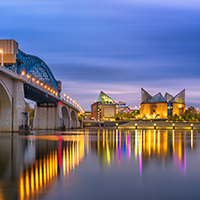When it comes to choosing a place to retire, it is possible to have it all: a vibrant, safe and affordable community that’s also easy on the planet. The five cities featured here are a sampling of places across the United States that are often awarded “best places to live” status—and they are that, indeed—but they qualified for Millie’s list based on more specific criteria.
They are affordable (and tax-smart) for retired people. They offer easy access to both health care and culture. And they are green to the core, from their public parks to their sustainability initiatives. Want to live green and stay golden? Read on.

Honolulu, Hawaii
Median Home Cost: $1 million for a home; $500,000 for a condo
Population: 339,421
Who doesn’t dream of retiring to the most exotic of the 50 states? Yes, it has all those iconic crescent beaches backed by palm trees, but it’s also a metropolis with the infrastructure needed to care for senior residents. Located on the island of O‘ahu’s South Shore, Honolulu offers all the wellness benefits of both green spaces and “blue spaces”—areas with bodies of water. Plumeria-scented air, cascading waterfalls, rainbows and lush mountainsides await. Plus, it’s only an hour to Waikiki Beach, one of the most famous beaches in the world.
To protect and preserve its incredible natural resources, the city won a 100 Resilient Cities Initiative grant from the Rockefeller Foundation in 2016, allowing it to hire a chief resilience officer to help tackle climate change. Eco-initiatives now include improving the city’s electricity and fuel use, increasing access to clean (and affordable) transportation options such as electric vehicles, planting more trees (the city has planted more than 45,500 trees since 2017 on its journey toward 100,000 trees by 2025), incorporating a water reuse system, reducing waste and using more renewable energy resources.
In 2020, the island of O‘ahu saw a 32.6% increase in electric vehicle registrations and the installation of nearly 6,000 new private rooftop solar systems. Plus: The city has pledged to achieve a net-negative carbon economy by 2045.
Cost of Living: Yes, it’s costly to live in paradise. The city ranked eighth on the most expensive places to live list by U.S. News & World Report and Honolulu’s cost of living—how much you’ll need to cover basic expenses—is 88% higher than the national average.
Inheritance Tax: None. But it does have a progressive estate tax ranging from 10% for lower earners to 15.7% for higher earners.
Health Care: Hawaii won the No. 1 spot for best health care in a nationwide survey by U.S. News & World Report, with top scores for health care access and health care quality. Plus, the Queen’s Medical Center in Honolulu was named the No. 1 hospital in the state.
Walkability: There are many areas to walk in Honolulu, but you’ll most likely need to use the public bus system to help you get around. Hang out downtown where you can lounge on the beach, do some café hopping and check out the thriving business center, or visit Waikiki Beach and stroll over to Kapi‘olani Park, the famed Royal Hawaiian Resort or luxury shops on Kalakaua Avenue. You can also go to Chinatown or the Art District galleries for fun weekend outings.

Portland, Oregon
Median Home Cost: $536,000
Population: 660,398
With a high LEED rating and policies encouraging green building practices, Portland beckons retirees with its lush, urban landscape, tree-lined streets and rich cultural life. It’s referred to as one of the greenest cities in the country, as Portland has worked to address climate change for more than 25 years. In 2018, the city reduced its emissions by 19%—while increasing economic growth by 36%—by improving the efficiency of its buildings, shifting to wind, solar and biodiesel energy sources, and reducing methane emissions from landfills with better recycling and composting programs. The city also plans to be 100% renewable and net zero by 2050.
Defined by the rivers that converge there—the Columbia and the Willamette—Portland especially values the health of its watershed. To improve water quality and protect the fish and wildlife habitats within the city limits, Portland launched a Grey to Green program, which increased green infrastructure to capture and manage stormwater, planted more than 32,200 trees, replaced nine culverts that blocked fish passage and built nearly 400 eco-roofs.
These initiatives not only benefit the environment but also offer residents plenty of natural landscapes to enjoy. They can amble through the Portland Saturday Market, bike around town or hike in Forest Park, one of the largest city parks in the nation with more than 5,000 acres of verdant woodlands. Nearby Mount Hood provides even more scenic wonder while the Willamette Valley attracts wine enthusiasts to its vineyards. Furthermore, in 2022, Portland was named the fourth healthiest city in the nation.
Cost of Living: With a rating of 130.8 (compared to the U.S. average of 100) on Sperling’s Best Places Cost of Living Index, Portland’s cost of living is quite a bit higher than in other cities.
Inheritance Tax: Oregon doesn’t have an inheritance tax, but it does charge its own estate tax (in addition to the federal estate tax), which starts at 10% and goes up to 16% depending on how much the estate is worth after the $1 million exemption.
Health Care: In 2014, Portland ranked as the fourth-best health care city in the nation—trailing only Boston, Washington, D.C. and Minneapolis—because of its quality, affordability and outcomes. (In 2019, Healthgrades ranked it No. 16.) Oregon Health & Science University in Portland was also named the No. 1 hospital in Oregon in U.S. News & World Report’s 2020-21 Best Hospital rankings.
Walkability: Portland ranked No. 7 on the 2019 walkable city list by George Washington University, with tons of cool neighborhoods where you can ditch the car and explore on foot (like the Pearl District and Downtown Portland).

Austin, Texas
Median Home Cost: $551,200
Population: 961,855
A cool, progressive, LEED-certified city in central Texas, Austin was voted the No. 1 place to live in America three years in a row by U.S. News & World Report (though in 2021 it was No. 5) and made AARP’s top 10 list of the most livable large cities. Why? It’s affordable, has a plethora of outdoor activities to choose from, serves delicious food and is known as the live music capital of the world (plus, it’s supposedly one of the best states for female entrepreneurs—just saying.)
Money magazine also named Austin one of its top five eco-friendly places to retire, in part because of its “Age-Friendly Austin Action Plan”—created by the City of Austin Commission on Seniors, AARP and other nonprofits. Some initiatives outlined in the plan include increasing green space accessibility for older adults of all income levels, with the goal of having a park or green space within one mile of every home, and helping seniors stay mobile with sidewalk repairs, public rideshare programs, discounted public transportation and more.
The city is also aiming for net-zero carbon emissions as soon as 2040, and its Office of Sustainability is working on an impressive ecological food plan that includes projects like the Central Texas School Garden Network, which aims to teach kids how to grow and harvest vegetables on-site; the Food Justice Mini Grant program, which awards money to groups helping with the food insecurity crisis; and the Good Food Purchasing Program, which will focus on environmental protections, animal welfare and building strong local economies.
Knowing the city is minding its green quotient, locals can enjoy the metropolis’s Hill Country scenery, including its reservoirs like Lake Austin and Lake Travis. These waterways attract active seniors looking to canoe, kayak, boat and sail their way through retirement. And public parks, such as Zilker Metropolitan Park with its 351 acres, offer walking and jogging trails to explore if you’d rather stay on dry land.
Cost of Living: Austin scored 119 on Sperling’s Best Places index, which is slightly higher than the national average.
Inheritance Tax: Texas doesn’t have an inheritance tax or an estate tax, but residents might still be subject to federal estate tax laws.
Health Care: With 50 metro-area hospitals and a physician-to-population ratio that tops other Texas metros, Austin’s health care system is diverse and comprehensive. Anticipating that the number of Texans age 65 and older will most likely increase to 8.3 million (17% of the state’s total population) by 2050, the state is already looking for new ways to provide even more services for retirees.
Walkability: Overall, the city is pretty spread out, so the easiest way to get from one place to another is to drive. There is, however, a 32-mile, nine-station MetroRail, as well as a bus system, that locals can use, and the city’s Age-Friendly Austin Action Plan aims to add even more options in the coming years. But certain neighborhoods, like Downtown and West University, scored 90 and 87, respectively, out of 100 on the Walk Score metric—which, unsurprisingly, rates the walkability of cities.

Chattanooga, Tennessee
Median Home Cost: $218,700
Population: 184,561
Once known as “America’s dirtiest city” and named by the EPA as America’s most polluted, Chattanooga is now praised for its green initiatives, chic cafes, riverside bars, vibrant nightlife and stunning parks. It was also twice awarded the No. 1 spot for outdoor activities by Outside magazine: The Tennessee River curls around downtown for scenic views and pleasant walks (like strolling across the Walnut Street Pedestrian Bridge into the North Shore area) and you’ll have access to Lookout Mountain with its sought-after hiking, waterfalls and ancient rock formations.
The city’s air is now cleaner than ever—through county-wide vehicle emissions testing, seasonal burning, diesel school bus retrofitting and more—and has electric shuttles, a Bike Share Transit System and sophisticated “day lighting” technology in its convention center. The area’s famous Ruby Falls was the first U.S. attraction to be certified by Green Globe, a sustainable tourism program, and has won the program’s Sustainable Leadership Award. Downtown, the Tennessee Aquarium is one of more than 30 LEED-certified buildings in the city and recycles water in its exhibits, has a composting program and uses energy-efficient appliances.
Plus, studies show that negative ions in the air, found in mountain and beach environments, help your body produce mood-boosting serotonin. So take a deep breath and enjoy.
Cost of Living: On Sperling’s index, Chattanooga rates 83.8, which is below the U.S. average, indicating its affordability. But affluent suburbs like Lookout Mountain (with a score of 132.7) cost more. There is no state income tax though, so that’s a plus.
Inheritance Tax: The State of Tennessee abandoned its inheritance tax in 2015, so that won’t be a problem anymore if you decide to move there. Bonus: The maximum estate tax is a low 9.5%.
Health Care: Options abound for elder care services and assisted living facilities in Chattanooga. The city’s CHI Memorial has been featured on U.S. News & World Report’s Best Regional Hospitals list and it received “high” ratings for procedures including knee and hip replacements, bypass surgery and eight treatments for chronic conditions. The region’s Erlanger Heart and Lung Institute also recently won the highest rating from the Society of Thoracic Surgeons for two procedures.
Walkability: WalkScore.com rates downtown Chattanooga as “very walkable,” with a score of 83 out of 100. You can also rent a standard bike (or e-bike) at one of the many bike stations and cruise along the Tennessee Riverwalk for 13 miles—stopping for food at the delicious restaurants or to look at art at the Hunter Museum and Bluff View Art District.

Bloomington, Indiana
Median Home Cost: $256,600
Population: 86,987
Bloomington offers wholesome and affordable Midwest living with an eco-conscious lens we admire. In 2020, the city’s sustainability initiatives were praised by the Midwest Energy Efficiency Alliance for employing “particularly unique, innovative and thoughtful initiatives”—landing it among the top three (out of 15) Midwest cities leading the way in climate action planning.
With a long-standing commitment to sustainability, the city has various green programs related to energy conservation, the local food movement, waste reduction and renewable energy—such as its Green Home Improvement Program, which helps families pay for energy-efficient upgrades to their homes, and Solarize Bloomington, which invested $13 million in solar panels for 32 municipal locations across the city.
Its environmental friendliness aside, Bloomington is consistently rated as one of the country’s top retirement destinations and is also one of five national Community AGEnda sites, meaning it receives grants (from Grantmakers in Aging and the Pfizer Foundation) to address the needs of its older population in unique, creative ways. One way it is doing this is through development of the Lifetime Community District, a wide range of housing options for retirees (cottages, condos, townhouses, artist colonies and more) along Bloomington’s iconic B-Line Trail, which runs through the city’s diverse, exciting downtown.
This means you can shop, browse the Community Farmer’s Market, socialize at a wide range of art galleries, get funky at the annual Lotus World Music and Arts Festival and other performing arts events, enjoy the college town culture and cuisine, and hike around Monroe Lake or the county’s wetland preserve—all without a car. Plus, Bloomington offers tons of educational opportunities for retirees who love to learn, such as Indiana University’s week-long “Mini-University” and courses at the IVY Tech Community College Lifelong Learning Center.
Cost of Living: Good news: Bloomington comes in at an 87.3 rating on Sperling’s index, which means it’s lower than the U.S. average.
Inheritance Tax: None here! And there isn’t an estate tax in Indiana either.
Health Care: Indiana University Health caters to older individuals with its many programs and resources, including Nurses Improving Care for Healthsystem Elders, which earned a “geriatric friendly” rating of three out of four stars. The facility has an Alzheimer’s and dementia resource center as well, with fall prevention programs, advance directives and hospice.
Walkability: The downtown district has the most walkable streets in the city, with a plethora of restaurants, bars, shops and more—including lively Kirkwood Avenue and The Square, the city’s heart and soul.
Millie content is licensed from Dotdash Meredith, publisher of Millie, Real Simple, InStyle, Investopedia, The Balance and more.
Jennifer Chappell Smith has more than 25 years’ experience writing about personal finance, lifestyle and more. She and her husband live in San Antonio, Texas, where they’re raising three boys, ages 12, 11 and 9.




